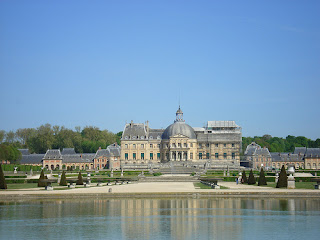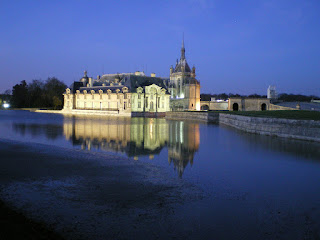Chantilly
cream with strawberries.
www.flickr.com/photos/fofie57/2688420718/
Chantilly Cream is forever linked with François Vatel (1631 – 1671), the chef and organizer of elaborate banquets for the French aristocracy. François Vatel was born Fritz Karl Watel in Paris to Swiss parents. He is also remembered as the chef whose standards were so high that he killed himself when his catering efforts did not meet his own standards.
Le Vaux-le-Vicomte
But Vatel is well known in French history from before either of the two episodes above. His fame began when he was the banqueter and chef to the Marquis and Vicomte Nicolas Fouquet. Fouquet was the Minister of Finance for King Louis XI, the Sun King and he had built himself an incredible chateau called Le Vaux-le-Vicomte with an artificial lake and fabulous gardens. After the chateau’s completion on August 17, 1661, Nicolas Fouquet invited the king to a banquet.
Le Vaux-le-Vicomte
www.flickr.com/photos/marilaneborges/1331514201/
The 22-year-old king was shown his minister's fantastic château, treated to a new play by Molière, an elaborate firework display, and then brought into the banquet. At the banquet, organized by Vatel, the king and his family were served pheasants and roast peacocks on solid gold platters accompanied by France’s finest wines. The chateau, its gardens and all of its splendor was far better than anything the king had and better than the kings planned Chateau de Versailles.
Part of
the gardens at Vaux-le-Vicomte
www.flickr.com/photos/zemzina/5827552005/
The King realized, with the help of his friends, that all of the money used to build the chateau came from taxes that were supposed to reach him. The king blew his stack and a few days later ordered Nicolas Fouquet thrown into prison. (Nicolas Fouquet's jailer, in real life, was d’Artagan, the head of the king’s Musketeers. He appears as the dashing musketeer in the book the Three Musketeers written in 1844 by Alexandre Dumas (pere)).
D’Artagnan,
the head of the king’s musketeers.
www.flickr.com/photos/empracht/21940905065/
François Vatel saw what had happened to his employer and took off into self-imposed exile. But the king had been impressed by the banquet as well as the architects, painters, and gardeners that had created this chateau and offered them all jobs at his new Chateau de Versailles.
The architect, Louis Le Vau, the painter and decorator Le Brun, and the landscape gardener Le Nôtre took the jobs offered by the king while Francoise Vatel the banqueter stayed in self-imposed exile.
Part of
the Potager de Roi, that Le Nôtre went on to create
The
king’s vegetable garden at Versailles.
Today
the gardens are a working agricultural school and may be visited all year
round.
There are guided tours in English and the tours are as
much about history as the chateau itself with heirloom peaches, apricots, cherries, strawberries, and much more.
www.flickr.com/photos/inra_dist/38468621294/
Vatel returns from exile.
When Vatel returned to France it was not to work for the king; it was to work for the Prince de Condé in the Château de Chantilly. The chateau is in the department of Oise in the new super region of Hauts-de-France, today it is just 60 km (37miles), by car, to the north of Paris.
Chateau
de Chantilly by night.
Vatel’s job was the Contrôleur Général de la Bouche, the man responsible for the purchase of the food and Prince’s elaborate banquet displays. At one of the first banquets that Vatel prepared in the Château de Chantilly, he presented the Prince de Condé with a new creation, called Chantilly cream. (It is probable that this creation had previously been offered to Fouquet under another name).
Vanilla in the
1600s
Chantilly cream is freshly whipped cream, sweetened with sugar and flavored with vanilla. At the time whipped cream was not new, but whipped cream sweetened with the expensive sugar and the even more costly vanilla was, in the 1600s was whipped cream born all over again.
Vanilla flavoring is still the most popular flavoring today, it is the world’s most common flavor, though much is synthetic. In the beginning, all the vanilla that reached Europe came from South America and so very little vanilla was available until the 1800s. We know from the discovery of wrecked treasure ships that 300 tons were the maximum weight a ship carried and many ships carried less than 100 tons. With most of the space given over to silver and gold, there was little room left for vanilla.
Vanilla reached France in the early 1500s when Jewish chocolate drink manufacturers who had fled the 1492 expulsion from Spain and Portugal set up shop in Bayonne in the south-west of France. Other than the cakes and chocolate drinks made by these early French chocolate manufacturers the first record we have was of pastries made with vanilla were for the Queen of England in the early 1600s. Vanilla for the masses would have to wait until the 1800s when it was successfully cultivated. Today Vatel may be turning in his grave, but the word Chantilly is often be used for any frothy creation of vegetables or fruits without any connection to cream or vanilla. While there are arguments over who first added vanilla to whipped cream the name Chantilly cannot be taken away from the chateau’s name or their history from the banqueter who worked there,
The Royal Banquets in the Chateau de Chantilly
In 1671 the Prince de Condé invited the whole of the royal court to three huge banquets. The court led by King Louis XIV arrived at the Château on Thursday 23 April 1671. The first banquet was a huge success despite the arrival of more guests than Vatel had been told to plan for. The second banquet was to be on Friday, a day when no meat could be served. There are endless disputes about the fish that was ordered and almost certainly in those days it would not have been saltwater fish for a huge banquet. The Atlantic coast is 240 km (miles) to the East that is ten to twelve days travel by ox-cart. Paris was closer and its markets received fresh fish from the Atlantic within one or two days via boats on the River Seine. Paris was only 50 km (30 miles) away from Chantilly as the crow flies but at least two to three days away by oxcart. This was the 1600s, and France had not yet begun to use ice to keep food fresh. Any saltwater fish for a banquet in Chantilly would have had to come from the Paris market. Oysters and mussels could be brought alive in damp straw but large quantities of saltwater fish in good condition would have been impossible.
None of the records show what fish was ordered for Vatel’s last banquet in Chantilly, but a savvy banquet organizer like Vatel would have ordered pike and trout along with other highly rated freshwater fish and crayfish that could be kept in holding pools and brought fresh whenever ordered. Freshwater fish in vast quantities would have been enough of a problem and saltwater fish would not, in any case, have impressed the king; fresh saltwater fish was part of the daily menu at in the area of Paris; it was brought in Fresh via the river Seine.
You catch your own pike today.
They may reach one meter in length (39”) and weigh over 15 kilos
(33lbs).
www.flickr.com/photos/jefren/3561130117/
As the story goes on the morning of Friday 24 April 1671, the fish delivered was too small a quantity for even for one-quarter of the guests. Vatel, an obsessive-compulsive, was full of remorse and shame; when he looked at the disaster awaiting the banquet for the king that night he fell upon his sword and died. The rest of the fish he had ordered arrived two hours later!
Francoise Vatel and French Haute Cuisine.
In the world of French cuisine, François Vatel is remembered as one of the early creators of truly elaborate banquets. Vatel's skill and creativity influenced the chefs of his time and all the French chefs for the next 100 years. Then, in the early 1800’s Antonin Carême brought order to French Haute Cuisine. Antonin took the works of Vatel and others and with his own additions wrote down for posterity the requirements for French Haute Cuisine. Only with the arrival of Escoffier and his collaborators some 70 years after Careme would any changes be made.
In the year 2,000, the director Roland Joffe made a film on Vatel starring Gerard Depardieu as Vatel. The film opened the Cannes film festival in the year 2000.
Visiting Le Vaux-le-Vicomte today.
When visiting Le Vaux-le-Vicomte today, you will not be offered a banquet; though in the summer they offer Saturday night dinners. Banquets or not, in all of France this is one château that should never be missed. Apart from visiting the magnificent building itself, you may drive yourself around the beautiful gardens and lake in golf carts, and not even King Louis could have done that.
To reach the Vaux-le-Vicomte by train takes about 25 minutes from Paris with a bus or taxi at the end. By car, it is 55 km (34 miles) and takes about one hour. Le Vaux-le-Vicomte is near the village of Maincy in the department Seine-et-Marne in the Île-de-France, southeast of Paris. It is 48 km from EuroDisney and 7 km from Melun home to one of France's top of the line Brie cheeses.
The Château de Chantilly today
www.flickr.com/photos/patrick_nouhailler/27626854645/
The Château de Chantilly with its enormous grounds today includes the Condé Museum and the recreated Potager des Princes, the vegetable garden of the Princes. The Château (rebuilt in the 1870's) is near the small town of Chantilly in the department of Oise, Picardie now part of the super region of Hauts de France, that borders Belgium. The gardens of Chantilly were designed by le Notre before he created the gardens at Le Vaux-le-Viscomte and the Château de Versailles.
The Chateau is just 54 km (34 miles) north of Paris by train with a 20 minutes bus or taxi ride from the station. By car, the chateau is 45 minutes from central Paris, outside the rush hour!
--------------------------------
Behind the French Menu
by
Bryan G. Newman
behindthefrenchmenu@gmail.com
Copyright 2010, 2014, 2017, 2019
--------------------------------
Searching for the
meaning of words, names or phrases
on
French menus?
you are searching for to the words
"Behind the French Menu" (best when including the inverted commas),
and search with Google, Bing, or another browser. Behind the French
Menu’s links, include hundreds of words, names, and phrases that are seen on
French menus. There are over 450 articles that include over 4,000 French dishes
with English translations and explanations.
Connected Posts:

















